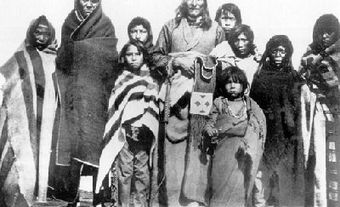
Historiography in English
Canadian historiography in the English language began virtually with British settlement in America. By necessity, it developed regionally, and it was practised by enthusiastic amateurs. Its raison d'être was less to examine the past for its own sake (for in the prevailing Eurocentric view Canada had little "real" history) than to depict the physical features of the land, compile social and economic statistics, and chronicle political advances in a way that encouraged further settlement and investment. It is best regarded as a literary genre aimed at promotion, descriptive rather than analytic.
The first example appeared in 1749, with the anonymous publication in London of A Geographical History of Nova Scotia. Other such accounts followed, culminating with T.C. HALIBURTON's An Historical and Statistical Account of Nova Scotia (1829), a tract intended to encourage a continued imperial connection.
Other British North American colonies and regions also contributed to this promotional literature during their formative stages. With the opening of the PRAIRIE WEST to European settlement in the 1870s, there appeared such works as Joseph James Hargrave's Red River (1871) and George Bryce's Manitoba (1882), tracts equally promotional but also reflecting an embryonic regional consciousness. In part this insistence on a distinctive western past was a reaction to the growing historiography produced by Ontarians in the 19th century.
In what is now Ontario, the first counterpoint to François-Xavier Garneau's Histoire du Canada was John Mercier McMullen's The History of Canada from Its First Discovery to the Present Time (1855). Unlike Garneau, McMullen stressed the "positive" implications of the DURHAM REPORT of 1839: the necessity and goodness of material progress, commercial expansion, British parliamentary institutions and colonial self-government. In this view Canada West (Ontario) was seen as both harbinger and guardian of such virtues; other regions were shunted to the periphery, regarded (as with Québec) either as impedimenta or (as with the West) as soil for possible Ontario-based expansion. The Maritime colonies were largely ignored.
The progress of Ontario in the latter 19th century lent an aura of legitimacy to this central Canadian view. CONFEDERATION in 1867 helped forge an equation of Ontario's past with the nation's past. Historical writing in Ontario, obsessed with material progress, preservation of the British connection and the achievement of RESPONSIBLE GOVERNMENT, remained promotional, but now was cast in the language of national destiny. By the mid-1880s journalist John Charles DENT had produced 2 major paeans to progress through political moderation: The Last Forty Years (1881) and The Story of the Upper Canadian Rebellion (1885).
In the next decade another dedicated amateur, engineer William Kingsford, produced the massive 10-volume History of Canada (1887-98), stressing the growth of local self-government out of the structures of imperial authority. At the end of the century the writing of Canadian history still remained largely the preserve of literary enthusiasts such as William KIRBY (The Golden Dog, 1877), Charles MAIR (Tecumseh, A Drama, 1886) and Charles G.D. ROBERTS (History of Canada, 1897).
Overlapping with this romantic approach to historical writing, however, was the growth of institutions that provided for gradual professionalization. This resulted ultimately in a profound shift from an emphasis on literary skill to an emphasis on professional discipline. In 1882 the formation of the Royal Society of Canada gave members their first national outlet for reading and publishing scholarly papers for an audience of peers. A second source of professionalization was the rapid expansion of English Canadian university curricula between 1880 and 1920.
In 1880 McGill University principal J.W. DAWSON could write that an educated man could gain a general knowledge of history "in an easy and delightful manner by his own reading." A specialized approach, it was thought, could be made simply by gaining a more thorough acquaintance with language and literature, not necessarily with historical documents. But by 1900 the study of history had achieved independence from classics, English literature and political economy, with which it had earlier been associated.
By the 1890s chairs of Canadian history existed at U of Toronto and Queen's U, and the subject was also taught by professors of history elsewhere, including U of Manitoba and Dalhousie U. By then, too, the historical romances of American historian Francis Parkman (eg, Montcalm and Wolfe, 2 vols, 1884) and the historical criticism of Goldwin SMITH (Canada and the Canadian Question, 1891) had shown that Canada's history was not necessarily parochial or lacking in significance.
At U of T, George WRONG combined moralistic narrative with a serious attempt to examine original sources, especially in A Canadian Manor and its Seigneurs (1908). George Bryce at Manitoba did likewise in his Remarkable History of the Hudson's Bay Company (1900).
Perhaps as important were the continuous efforts made by Wrong and Bryce to divorce the writing of history from mere antiquarianism. Bryce was active in the Historical and Scientific Society of Manitoba (fd 1879), and by 1897 Wrong had founded the Review of Historical Publications Relating to Canada at U of T. The energies of both men were directed at introducing principles of historical criticism into Canadian historiography. Kingsford's approach was now deemed fundamentally inadequate because of its weak citation of archival sources and its insubstantial interpretive perspective.
With the creation in 1872 of the Public Archives of Canada (see NATIONAL ARCHIVES OF CANADA) under Douglas Brymner, there was increasingly little excuse for failing to consult basic manuscript and public records. The new preoccupation with empirical verification was also expressed in the writings of Adam SHORTT, who taught Canadian history at Queen's from the early 1890s to 1907.
First in a series of studies of Canadian economic and financial institutions, and later in CANADA AND ITS PROVINCES (23 vols, 1913-17) which he conceived and edited with Arthur DOUGHTY, Brymner's successor as Dominion Archivist, Shortt refused to engage in the nationalistic moralizing which was characteristic of Bryce and Wrong. Moreover, Canada and Its Provinces, focusing on the growth of Canada as a nation-state, nevertheless remained sensitive to regional distinctiveness and "provincial history." Like the idealist philosophers under whom he had studied while a student at Queen's, Shortt sought to reconcile multiplicity and unity while undermining the significance of neither.
The new academic historians' commitment to empirical verification and "objective" judgement in the first 2 decades of the 20th century did not, however, mean the death of the earlier literary and romantic approach. Instead, "men of letters" turned to BIOGRAPHY, greatly aided by the decision of Toronto publisher George Morang to create a multivolume biographical MAKERS OF CANADA SERIES.
The original series and an index, published 1903-11, were written by academics and laymen and marked the apogee of Carlylean hero worship and whiggish progressivism. All subjects were, in some manner, Canada's "Founding Fathers," usually in politics. They were portrayed as "makers" of Canada's national and independent future, not as contributors to its colonial past. Egerton RYERSON was therefore suitable for inclusion; Bishop John STRACHAN was not.
Nor was serious criticism of these "makers" to be brooked. When William Dawson LESUEUR, an editor of the series, submitted a manuscript on William Lyon MACKENZIE that was critical of the rebel, his volume was unceremoniously rejected. It was 71 years before this first "modern" Canadian historical biography was published as William Lyon Mackenzie: A Reinterpretation (1979).
In spite of the broad emotional appeal of the Makers of Canada series, by 1920 biographical history as represented by the series no longer represented the work being done by the historical profession, increasingly trained at British and American graduate schools. In 1922 the CANADIAN HISTORICAL ASSOCIATION was founded, its publishing vehicle the CANADIAN HISTORICAL REVIEW (which supplanted Wrong's Review of Historical Publications).
English Canadians had emerged from WWI with a new sense of psychological distance from the British Empire. An emotional attachment still existed, but there was a sense that soon Canada must declare full independence, except in allegiance to the British monarch. The relationship between empire and nation was to preoccupy the next generation and more of English Canadian professional historians.
As a consequence, the interwar years witnessed the publication of several major attempts at understanding Canada's complex international status. Most notable among these were W.P.M. KENNEDY's The Constitution of Canada (1922) and Chester Martin's Empire and Commonwealth (1929). One legacy of the Great War had been an increase in autonomist forms of nationalism and an acceptance of the US as a genuine world power.
Accordingly, some historians began to study CANADIAN-AMERICAN RELATIONS. Young Canadian historians such as Arthur LOWER and F.H. UNDERHILL, influenced by American progressive historians such as Frederick Jackson Turner and Charles A. Beard, began to stress common geographical, political and economic attributes of 2 nations sharing a continent.
This view gained further legitimacy from the growing interdependence of the Canadian and US economies and cultures. Books internationalist in scope and comparative in structure began to appear, most notably by John Bartlet BREBNER : New England's Outpost (1927), The Explorers of North America, 1492-1806 (1933) and The Neutral Yankees of Nova Scotia (1937). The search for continental links found popular expression in journalist J.W. DAFOE's series of essays, Canada: An American Nation (1935).
Increasingly, the categories of American historical analysis were used to give new meaning to Canada's past. This tendency increased as American scholars turned to the study of American-Canadian relations. One massive expression of this CONTINENTALISM was the Carnegie series on Canadian-American relations, 25 volumes by scholars from both countries under the editorship of James T. Shotwell and published 1936-45. In 1945 appeared Brebner's summary volume for the series: The North Atlantic Triangle.
English Canadian historical scholarship between the wars was dominated by a concern for establishing the environmental determinants of Canadian history. Underhill, for example, stressed north-south political and economic continental links much as had his intellectual mentor, Goldwin Smith.
A different form of environmental determinism was set forth by U of T political economist Harold INNIS. In a series of comprehensive studies of Canadian economic history (especially The Fur Trade in Canada, 1930) Innis articulated what came to be known as the STAPLE THESIS. This complex argument, made with great attention to historical detail, stressed that the fundamental material and economic determinants of Canadian history were ones that linked the hinterland economy of Canada to the metropolitan centres of Europe, particularly Britain (see METROPOLITAN-HINTERLAND THESIS).
The reciprocal relationship between the exploitation of Canadian products and the demands of Europe forged a transatlantic east-west economic axis that transcended north-south continental imperatives. Other aspects of historical development, such as cultural, political and urban growth, were in his view of secondary importance.
Innis's interpretation provided an important means for Canadian historians dissatisfied with continentalist views to remain environmentalists while stressing European, especially British, economic and cultural ties. This was particularly true of Donald CREIGHTON, whose THE COMMERCIAL EMPIRE OF THE ST. LAWRENCE appeared in 1937. This seminal book owed much to Innis's focus on the transatlantic nature of staple development, but concentrated on the centrality of the ST LAWRENCE RIVER system and the colonial merchants who, after the Conquest, shaped a transcontinental economy.
Thus was born the LAURENTIAN THESIS, the dominant interpretation of Canadian history until the 1960s. Creighton himself expanded upon it, most notably in his magisterial biography, John A. Macdonald (2 vols, 1952-55), in which Macdonald became the personification of national will, and his great achievement, the construction of the CANADIAN PACIFIC RAILWAY, marked the transcontinental extension of the empire of the St Lawrence to the Pacific. Much of Creighton's great appeal in the 1940s and 1950s was due to the way his works artfully combined initiative and will with social and economic factors, in his words "Character" with "Circumstance."
The effect of Creighton on his generation was profound. His Dominion of the North (1944), Canada's First Century (1970) and other works kept the Laurentian thesis at the forefront of interpretations of nation-building in Canada, and his biography of Macdonald helped rehabilitate biography as a genre of history. Other scholars produced major studies of neglected figures, most notably J.M.S. CARELESS (Brown of The Globe, 2 vols, 1959-63) and Roger Graham (Arthur Meighen, 3 vols, 1960-65).
By 1960, in fact, political biography had become the dominant form of historical writing in English Canada, in part because of the extraordinary literary power of Creighton's Macdonald and in part because of the post-1945 generation's reaction to the rigidities and restrictiveness of economic determinism in the social sciences. At mid-century, the practice of Canadian history was still very much part of the humanist's domain.
The "Laurentian school" was not without its critics, most notably W.L. MORTON, whose 1946 essay "Clio in Canada: The Interpretation of Canadian History" had been a major indictment of the hegemonic and exploitative implications of Laurentianism for regions other than central Canada. In his own writings, including The Progressive Party in Canada (1950) and Manitoba (1957), Morton had made major contributions to the history of a region neglected (except in its role as hinterland) by Laurentian historians, just as G.F.G. STANLEY had done earlier in The Birth of Western Canada (1936).
But in the 1960s the assumptions of the Laurentian school began to be codified for a new generation in the Canadian Centenary Series, a projected 18-volume comprehensive history of Canada edited by Morton and Creighton. Most volumes in the series (expanded to 20) have now been published.
The exponential growth of Canadian universities, especially graduate schools, in the 1960s and early 1970s, fundamentally altered the direction of Canadian historiography. The financial support of the CANADA COUNCIL (and later the SOCIAL SCIENCES AND HUMANITIES RESEARCH COUNCIL) greatly facilitated scholarly research, writing and publication. Graduates from "regional" universities turned increasingly to studies of urban, ethnic, working class and feminist historiography, often within regional settings. International scholarship, especially the "New Social History" of the 1960s, markedly influenced such scholars, and major works were often set within a framework critical of capitalist social and economic relations.
Specialized journals, such as Acadiensis, B.C. Studies, Labour/Le Travailleur and Urban History Review / Revue d'histoire urbaine, met with an enthusiastic response from the scholarly community. By the late 1970s the earlier attempts at a "national synthesis" had become the subject of much criticism for their failures to account for forms of regional distinctiveness and their singular emphasis upon members of the English and French middle class and their political representatives. Carl Berger's study of the national historians, The Writing of Canadian History (1976), was an eloquent capstone to this earlier historiography.
Since the mid-1970s historians have pursued the many "limited identities" to which J.M.S. Careless and Ramsay Cook had earlier called attention. The historiography of regions, gender, social class, cities and ethnicity, among others, continued to flourish. That of the nation, whatever that now meant to historians, was largely ignored. Little "national" political or constitutional history was written, and topics such as "Confederation," staple items of the profession in the 1950s and 1960s, failed to find major historical interpreters.
The results were ambiguous and ironic. Students of Canadian history knew much more about the particularities of their collective pasts, but the absence of any major new synthesis of that important scholarship meant that the academic pursuit of "limited identities" had at times produced "limited perspectives" for readers of Canadian history.
By the late 1980s academic historians had been accused by "popularizers" such as Pierre Berton and Peter C. Newman of having abandoned their public readership in their quest for the esoteric. Academic historians responded with equally acrimonious accusations of the "popularizers" that their attempts to sell books by focusing on the elusive national identity had led them to reductionist and stereotyped interpretations of Canada's past.
See also HISTORIOGRAPHY; HISTORIOGRAPHY IN FRENCH.

 Share on Facebook
Share on Facebook Share on X
Share on X Share by Email
Share by Email Share on Google Classroom
Share on Google Classroom


